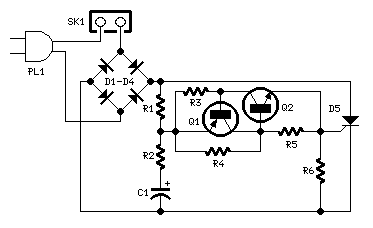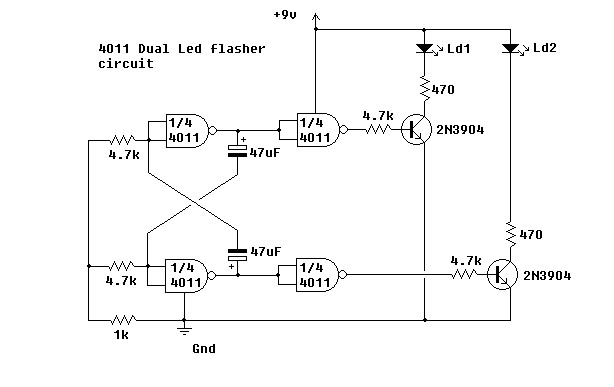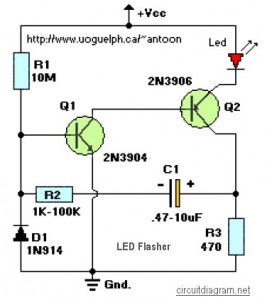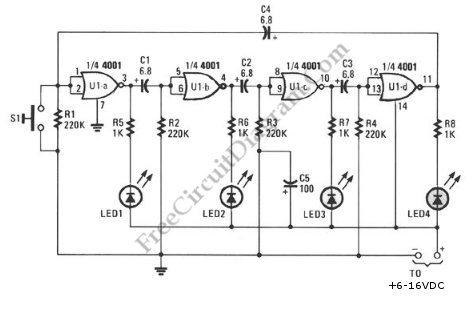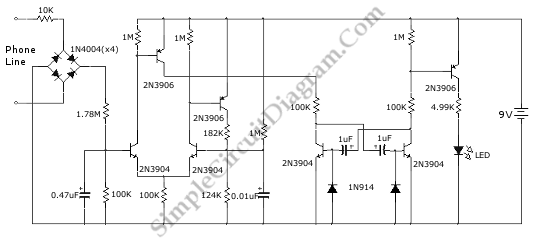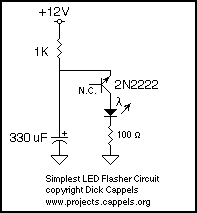
Sequential flasher
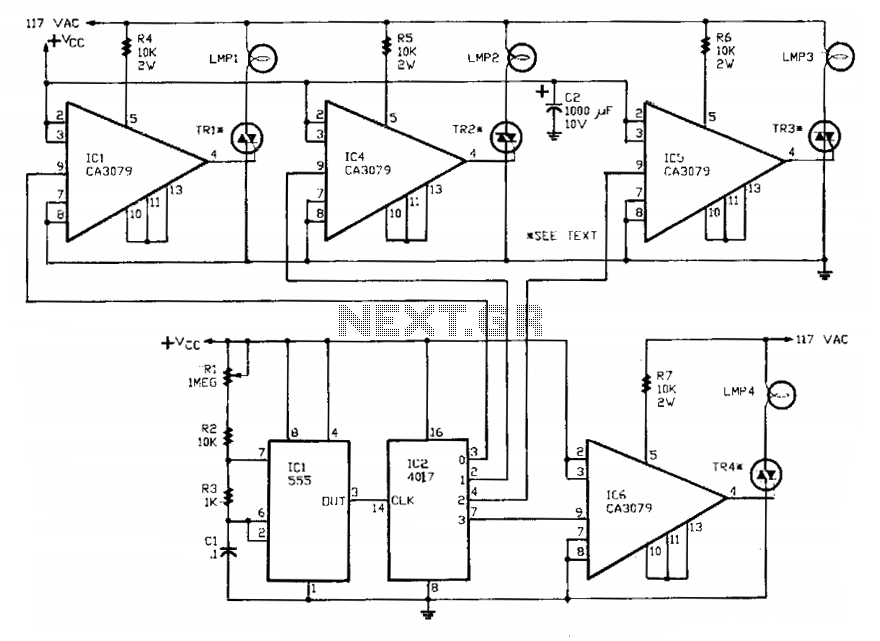
A 555 timer, referred to as IC1, controls a 4017 CMOS decade counter. The first four outputs of the 4017 drive a CA3079 zero-voltage switch. Pin 9 of the CA3079 is utilized to inhibit output from pin 4, which disables the series of pulses that the IC typically generates. These pulses occur every 8.3 milliseconds, corresponding to a frequency of 120 Hz, with each pulse having a duration of 120 microseconds. The operation of the CA3079 allows the lamps connected to the TRIACs to turn on and off close to the zero crossing of the AC waveform. This method of switching enhances lamp longevity by minimizing the inrush current that would occur if the lamp were activated near the peak of the AC waveform.
In addition, switching at the zero crossing significantly reduces Radio-Frequency Interference (RFI). It is important to note that the CA3079s are directly driven from the 117-volt AC power line, necessitating caution during implementation.
The circuit employs a 555 timer configured in astable mode, generating a continuous square wave signal. This signal is fed into the clock input of the 4017 decade counter, which counts the pulses and sequentially activates its outputs. The first four outputs of the 4017 are connected to the control inputs of the CA3079 zero-voltage switches, which are designed to control the TRIACs responsible for the lamp operation.
The CA3079 zero-voltage switch is a critical component that ensures the TRIACs are activated only when the AC voltage is near zero, effectively reducing stress on the lamps and extending their operational life. The inhibition feature provided by pin 9 allows for precise control over the output, enabling the user to disable specific outputs when necessary.
The timing characteristics of the circuit, with a pulse width of 120 microseconds and a frequency of 120 Hz, are suitable for applications requiring efficient switching of resistive loads such as incandescent lamps. By minimizing the inrush current and switching at the zero crossing, the circuit not only enhances the lifespan of the lamps but also mitigates the potential for RFI, making it a reliable solution for lighting control in various environments. Safety precautions should be strictly observed when working with the CA3079, given its direct connection to the high-voltage AC power line.A 555 timer, IC1, drives a 4017 CMOS decade counter. Each of the 4017's first four outputs drives a CA3079 zero-voltage switch. Pin 9 of the CA3079 is used to inhibit output from pin 4, thereby disabling the string of pulses that IC normally delivers. Those pulses occur every 8.3 ms, i.e., at a rate of 120 Hz. Each pulse has a width of 120 jis. Due to the action of the CA3079, the lamps connected to the TRI-AC's turn on and off near the zero crossing of the ac waveform.
Switching at that point increases lamp life by reducing the inrush of current that would happen if the lamp were turned on near the high point of the ac waveform. In addition, switching at the zero crossing reduces Radio-Frequency Interference (RFI) considerably. CAUTION: The CA3079's are driven directly from the 117-volt ac power line, so use care. 🔗 External reference
In addition, switching at the zero crossing significantly reduces Radio-Frequency Interference (RFI). It is important to note that the CA3079s are directly driven from the 117-volt AC power line, necessitating caution during implementation.
The circuit employs a 555 timer configured in astable mode, generating a continuous square wave signal. This signal is fed into the clock input of the 4017 decade counter, which counts the pulses and sequentially activates its outputs. The first four outputs of the 4017 are connected to the control inputs of the CA3079 zero-voltage switches, which are designed to control the TRIACs responsible for the lamp operation.
The CA3079 zero-voltage switch is a critical component that ensures the TRIACs are activated only when the AC voltage is near zero, effectively reducing stress on the lamps and extending their operational life. The inhibition feature provided by pin 9 allows for precise control over the output, enabling the user to disable specific outputs when necessary.
The timing characteristics of the circuit, with a pulse width of 120 microseconds and a frequency of 120 Hz, are suitable for applications requiring efficient switching of resistive loads such as incandescent lamps. By minimizing the inrush current and switching at the zero crossing, the circuit not only enhances the lifespan of the lamps but also mitigates the potential for RFI, making it a reliable solution for lighting control in various environments. Safety precautions should be strictly observed when working with the CA3079, given its direct connection to the high-voltage AC power line.A 555 timer, IC1, drives a 4017 CMOS decade counter. Each of the 4017's first four outputs drives a CA3079 zero-voltage switch. Pin 9 of the CA3079 is used to inhibit output from pin 4, thereby disabling the string of pulses that IC normally delivers. Those pulses occur every 8.3 ms, i.e., at a rate of 120 Hz. Each pulse has a width of 120 jis. Due to the action of the CA3079, the lamps connected to the TRI-AC's turn on and off near the zero crossing of the ac waveform.
Switching at that point increases lamp life by reducing the inrush of current that would happen if the lamp were turned on near the high point of the ac waveform. In addition, switching at the zero crossing reduces Radio-Frequency Interference (RFI) considerably. CAUTION: The CA3079's are driven directly from the 117-volt ac power line, so use care. 🔗 External reference
Warning: include(partials/cookie-banner.php): Failed to open stream: Permission denied in /var/www/html/nextgr/view-circuit.php on line 713
Warning: include(): Failed opening 'partials/cookie-banner.php' for inclusion (include_path='.:/usr/share/php') in /var/www/html/nextgr/view-circuit.php on line 713
